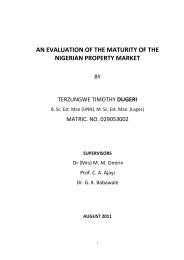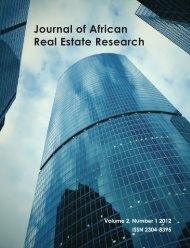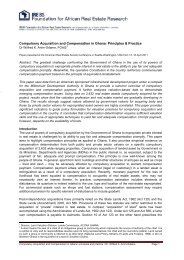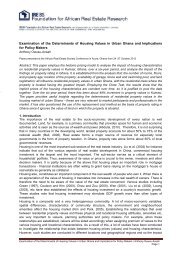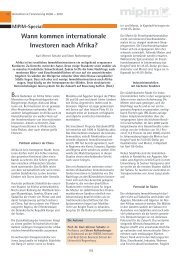egistration form with the the Finance Ministry (charges10% of the capital and FCFA1 000 per page);obtaining the Ministry of Industry and Commerce’sadministrative authorization;advertising the company formation in a national dailynewspaper;registering the company with the Registry of Commerceand Real Estate;registering tax rolls;registering a statistics code;registering the company with the Ministry of Finance’scentral tax services;submitting an Internal Regulation Code;establishing the company seal (about FCFA18 000);social security registration.It should take an estimated 75 days to complete theseprocedures.Exchange ControlsWith government approval, both residents and non-residentsmay hold foreign exchange accounts. The opening of foreignaccounts in FCFA for the benefit of non-residents is free in theCentral <strong>Africa</strong>n Economic and Monetary Community (CEMAC).TaxationCompany tax is 45% of corporate profits and 25% of rentalproperties income. A turnover tax of 15% applies to all servicesand products. Being a member of the Central <strong>Africa</strong>n Customsand Economic Union (UDEAC), Chad has reformed its import andvalue-added taxes.Imports/ExportsSince 2000, Chad has experienced a trade surplus. Cotton andcrude oil are the most prominent export products for Chad’seconomy. The EU and the US are the largest trading partners interms of cotton, accounting for almost 90% of Chad’s exports.Machinery and heavy transportation equipment are the majorimport items. Chad also imports textile materials and food andconsumer goods on a large scale. The European Union is themost significant partner for imports. Chad ranks 54 in the worldin terms of total oil exports. Chad has approximately 1.5 billionbbl in oil reserves in 2009. This sector also attracts huge foreigninvestment. The biggest Chadian oil production unit is controlledby ExxonMobil. Before oil production began in Chad, cotton wasthe dominating export product. The Chad cotton industry hasdeclined since 2000 due to a fall in the international cottonprices. However, the government is seeking foreign investmentto revive the cotton industry in the country.Monetary PolicyChad is a member of the Central <strong>Africa</strong>n Economic and MonetaryCommunity (CEMAC) which was created in 1991 to improveeconomic and political cooperation in the region. Monetarystability remains under control but the government influencesprices through state owned enterprises and regulation of keygoods and services. The Bank of Central <strong>Africa</strong>n States (BEAC)runs fiscal policies at the regional level. Its priorities arecontrolling inflation and keeping the CFA Franc pegged to theEuro. Chad has a cautious external debt policy and most of itsloans are on very soft terms.Legal SystemChad’s legal system is based on French civil law, modifiedaccording to a variety of traditional and Islamic legalinterpretations.The judiciary comprises the Supreme Court, Court of Appeal,criminal courts, magistrate courts and a Tribunal. Besides theregular courts, the 1996 constitution established aConstitutional Council to control the conformity of laws andinternational treaties and agreements with the constitution, toentertain disputes arising from presidential and legislativeelections and to monitor the lawfulness and proclaim the resultsof referendums. The constitution also provides for theinstitution of a High Court of Justice, which is able to try thepresident of the republic and members of the government incases of high treason.Chad also has an unofficial but widely accepted system of IslamicSharia courts in the north and east, which have operated for acentury or more. Civil courts often consider traditional law andcommunity sentiment in decisions and the courts sometimesseek the advice of local leaders in considering evidence andrendering verdicts.Intellectual PropertyChad is part of the <strong>Africa</strong>n Regional Intellectual PropertyOrganization (ARIPO), which amended the 1977 Bangui Protocoland sets out common procedures based on a uniform system ofprotection (in addition to provisions included in internationalconventions to which member states accede).Financial Services/InsuranceThe insurance sector in Chad is very small and dominated by aformerly state-owned insurance company. The Inter-<strong>Africa</strong>nConference on Insurance Markets (CIMA) regulates the sector.South <strong>Africa</strong>n-based insurance companies, offering primarilyPan-<strong>Africa</strong>n insurance products, and European insurancecompanies, also serve the insurance market.Key Strategic Growth Initiatives by Government/Private SectorThe initiatives and objectives of the government are theexpansion and improvement of the transportation andtelecommunications networks, the expansion anddiversification of agriculture (cotton, food crops) and theexploitation of oil and minerals like soda ash, rock salt,chromium, tungsten and titanium.Treaties and Bilateral AgreementsInternational treaties are dealt with under title XIV (articles 217to 221) of the Chadian constitution. International treaties arenegotiated and ratified by the president but the ratification ofsome treaties needs the authorization of the Parliament. Theseinclude peace treaties, defence treaties, trade treaties, treatiesrelating to the use of the national territory or the exploitation ofnatural resources, agreements relating to international<strong>org</strong>anisations, treaties involving state finances and treatiesrelating to the status of persons. Treaties involving the transfer,exchange and addition of territory need the consent of thepeople by a referendum. International treaties and agreementshave to be compatible with the Constitution. Once a treaty islawfully ratified and published, it is superior to nationallegislation.Membership of International and Regional OrganisationsChad is a member of many international andregional <strong>org</strong>anisations such as the WorldBank, the United Nations (UN)), the <strong>Africa</strong>nUnion (AU) and its New Partnership for<strong>Africa</strong>’s Development (NEPAD) programme,the Economic Community of Central <strong>Africa</strong>n23
States (ECCAS), the Central <strong>Africa</strong>n Economic and MonetaryCommunity (CEMAC) and the Central <strong>Africa</strong>n Customs andEconomic Union (UDEAC).AgricultureAgriculture provides employment for 80% of the country’slabour force with most farming taking place at a subsistencelevel. Cotton and livestock are the two most important products—both earn significant foreign revenue for the country. Theeffective development of the agricultural sector is hampered byharsh environmental conditions and a lack of infrastructure.Trade and InvestmentOil and mineral reserves (gold, natron and marble) have nowattracted interest from investors. Spirulina, shea trees andsesame seed oil are potential areas of investments.Labour RelationsAccording to the <strong>Africa</strong> 2010 survey, over 80 percent of theworkforce is engaged in unpaid subsistence farming, herdingand fishing. A unionized labour code has been drawn up inconjunction with the World Bank. Mandatory allowances forworkers include transportation, health, indemnity, bonuses, andvacation pay.Significant Issues for Investors to ConsiderChad is handicapped by its landlocked position. Trade, includingexports and imports, must pass through Cameroon wherecorruption is a problem. Energy prices in Chad are among thehighest in the world and variable rainfall causes frequent deficitsin food production. Heavy taxes, corruption, and the lack of anindependent judiciary have discouraged foreign investment.Economic DevelopmentsChad’s first oil company, Société des Hydrocarbures du Tchad,was formed in 2006 to give Chad greater control over its energyreserves. This was followed by tensions between thegovernment and multinational oil firms like Chevron andPetronas over unpaid taxes. Both Libya and France haveprovided generators to increase the Chadian electricity supply.Road and TransportTransport infrastructure within Chad is generally poor, especiallyin the north and east of the country. There are no railways andriver transport is limited to the south-west corner. Roads aremostly untarred and are likely to be impassable during the wetseason, especially in the southern half of the country. In thenorth, roads are merely tracks across the desert and land minescontinue to be a danger. Draft animals (horses, donkeys andcamels) remain important in much of the country. There are 59airports/airfields.WaterChad’s cities face serious difficulties in municipal infrastructure:only 48% of urban residents have access to potable water andonly 2% to basic sanitation.EnergyChad’s energy sector has suffered from years of mismanagementby the parastatal Chad Water and Electric Society (STEE), whichprovides power for 15% of the capital’s citizens and covers only1.5% of the national population. Most Chadians burn biomassfuels such as wood and animal manure for power.TelecommunicationsThe telecommunication system is basic and expensive, withfixed telephone services provided by the state telephonecompany Sotel Tchad. Only 14 000 fixed telephone lines serve allof Chad, one of the lowest telephone density rates in the world.Trade and IndustryChad’s most important export products include cotton, cottontextiles and livestock. It exports these products to countries suchas Nigeria, South <strong>Africa</strong>, Costa Rica, France, Portugal, Germanyand Thailand. Foodstuffs still constitute most of the country’simports. Other imported products include machinery andtransportation equipment and industrial goods.MiningThe mining sector in Chad remains largely undevelopedalthough preliminary studies suggest that there is muchpotential. Highly promising areas for gold, bauxite, uranium,silver and alluvial diamonds have been identified. The 1995Mining Code regulates the sector.OilExxonMobil leads a consortium of Chevron and Petronas thathas invested US$3.7 billion to develop oil reserves estimated atone billion barrels in southern Chad. Oil production began in2003 with the completion of a pipeline (financed in part by theWorld Bank) that links the southern oilfields to terminals on theAtlantic coast of Cameroon. As a condition of its assistance, theWorld Bank insisted that 80% of oil revenues be spent ondevelopment projects. In January 2006 the World Banksuspended its loan programme when the Chadian governmentpassed laws reducing this amount. On 14 July 2006, the WorldBank and Chad signed a memorandum of understanding underwhich the Government of Chad commits 70% of its spending topriority poverty reduction programmes.In 2004, Chad had 550 km of tarred roads and 33 133 km ofuntarred roads. With no railways of its own, Chad dependsheavily on Cameroon’s rail system for the transport of Chadianexports and imports to and from the seaport of Douala inCameroon.In terms of waterways, most rivers flow intermittently. On theChari, between N’Djamena and Lake Chad,transportation is possible year round. Totalwaterways cover 4 800 km, of which 2 000 kmare navigable all year round.24




